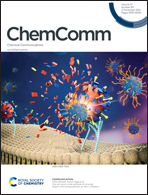Photochemical bromination and iodination of peptides and proteins by photoexcitation of aqueous halides†
Abstract
Although halogen atoms can greatly improve the stability, selectivity, and bioactivity of proteins, direct halogenation of proteins or peptides by chemical strategy has been never achieved. Herein, we describe the developments of direct photochemical bromination and iodization of unprotected proteins and peptides in the direct irradiation device and the single-pulsed irradiation capillary reactor with biocompatible aqueous halides Br− and I−, respectively. These novel photochemical modifications are triggered by 193 nm laser photoexcitation of commonly photo-inert halide ions to form active radical species. High protein modification efficiency (>90%) can be achieved under just 10 ns ultra-short irradiation of a single pulse of laser shot while the compact native protein structure could be largely retained. The specifically modified residues are Tyr, His, Trp for bromination and Tyr, His for iodization. The photochemical halogenation sites and rates are highly selective to protein native structures, providing dynamic insights into protein structure alterations and protein–drug interfaces in human serum protein (HSA)–warfarin interaction. This novel 193 nm photochemical strategy opens new opportunities for the protein structure–function explorations.



 Please wait while we load your content...
Please wait while we load your content...